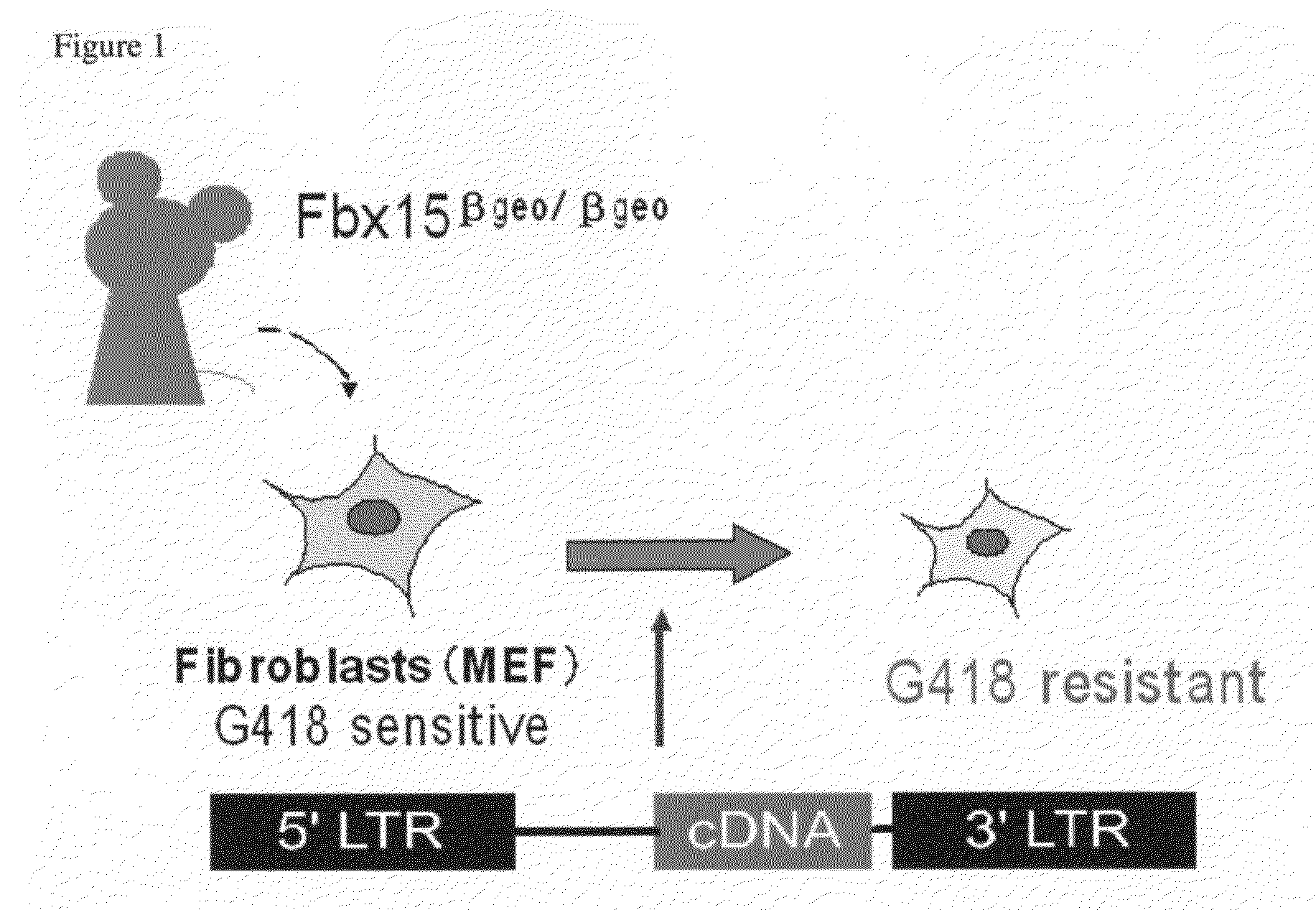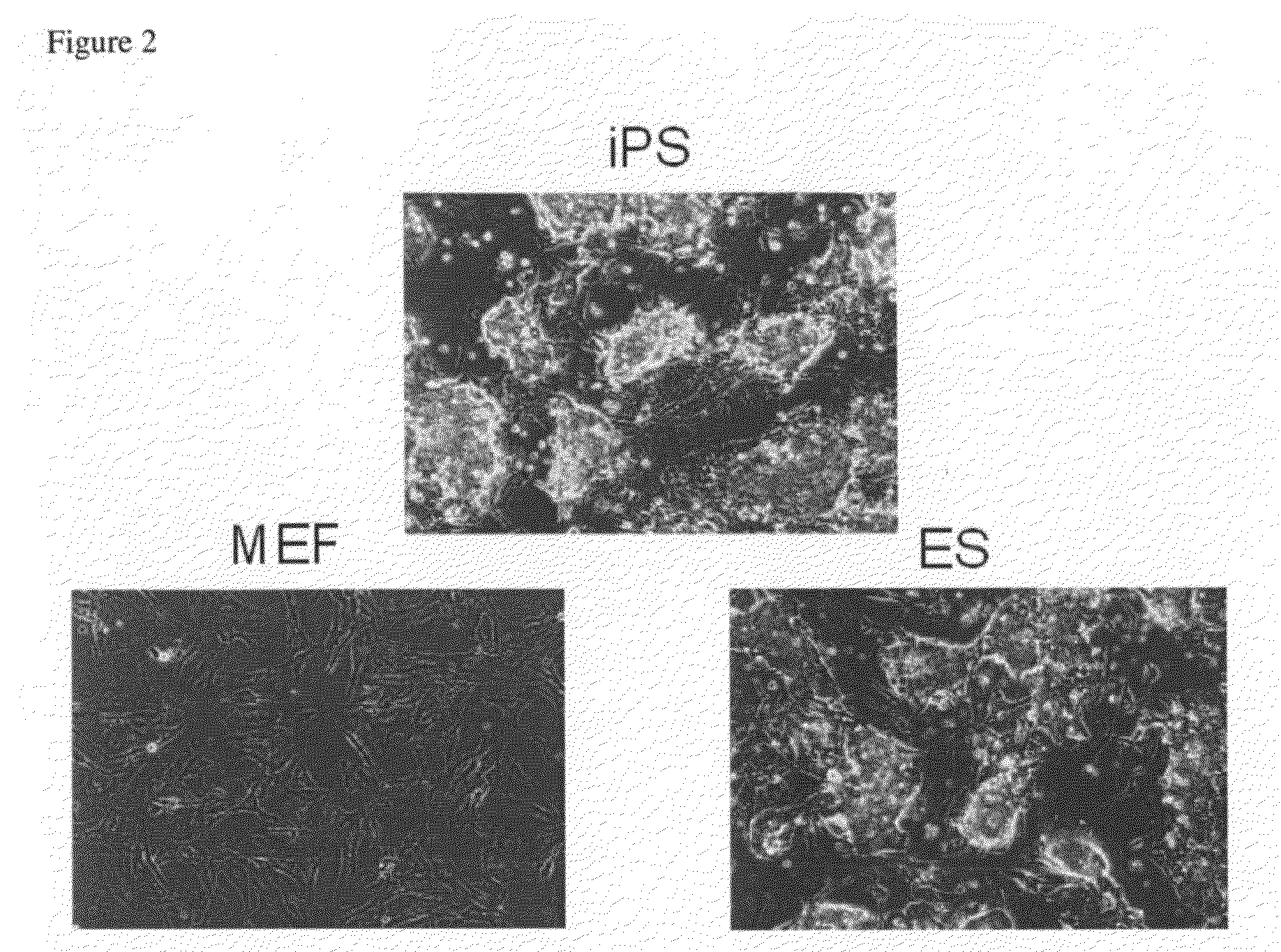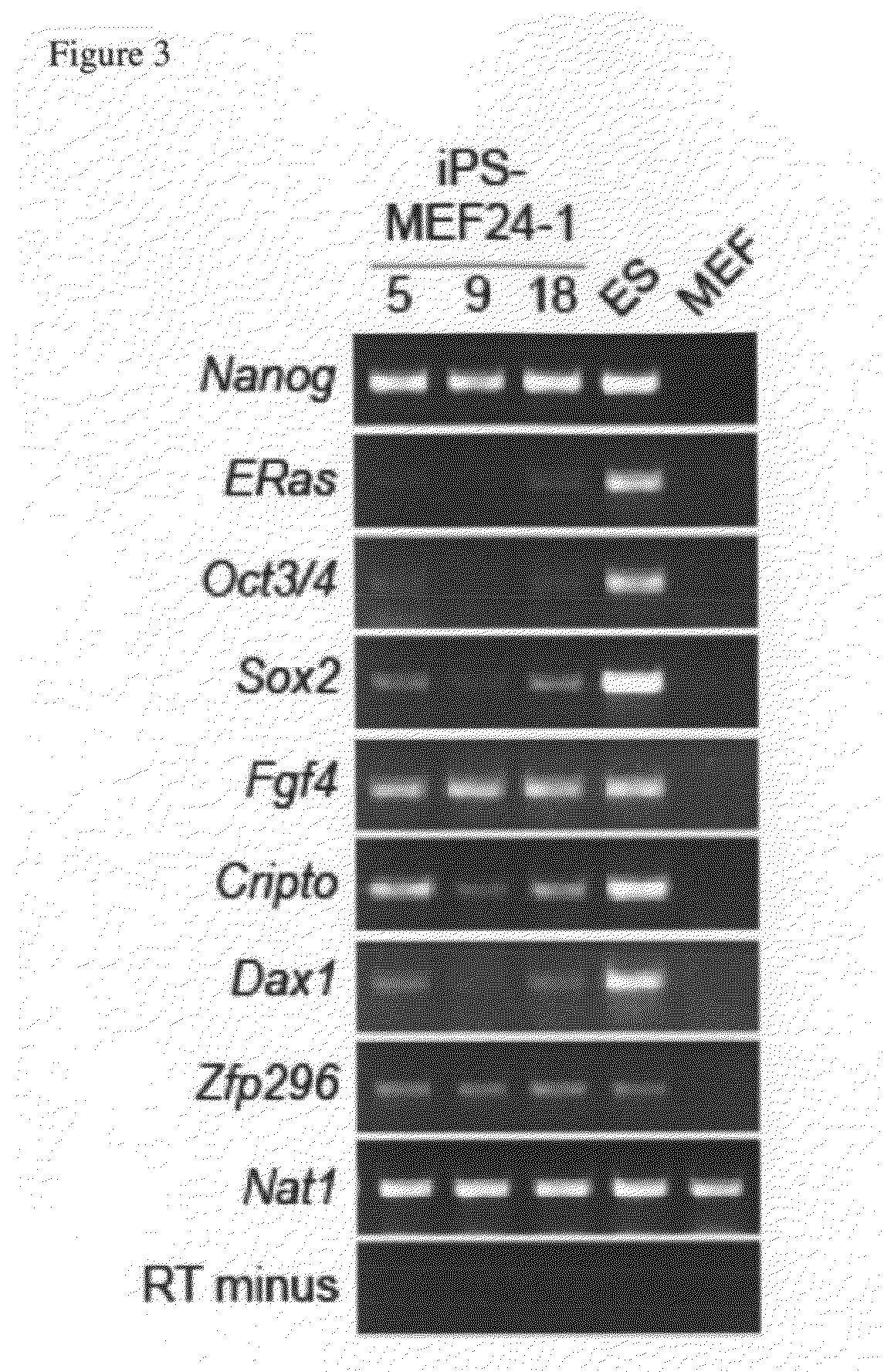[0120]By using the nuclear
reprogramming factor of the present invention, the
nucleus of a
somatic cell can be reprogrammed to obtain an
induced pluripotent stem cell. In the specification, the term “induced pluripotent stem cells” means cells having properties similar to those of ES cells, and more specifically, the term encompasses undifferentiated cells having pluripotency and growth ability. However, the term should not be construed narrowly in any sense, and should be construed in the broadest sense. The method for preparing induced pluripotent stem cells by using a nuclear reprogramming factor is explained in International Publication WO2005 / 80598 (the term “ES-like cells” is used in the publication), and a means for isolating induced pluripotent stem cells is also specifically explained. Therefore, by referring to the aforementioned publication, those skilled in the art can easily prepare induced pluripotent stem cells by using the nuclear reprogramming factor of the present invention. Methods for preparing induced pluripotent stem cells from somatic cells by using the nuclear reprogramming factor of the present invention are not particularly limited. Any method may be employed as long as the nuclear reprogramming factor can contact with somatic cells under an environment in which the somatic cells and induced pluripotent stem cells can proliferate. An
advantage of the present invention is that an
induced pluripotent stem cell can be prepared by contacting a nuclear reprogramming factor with a somatic cell in the absence of eggs, embryos, or embryonic stem (ES) cells.
[0121]For example, a
gene product contained in the nuclear reprogramming factor of the present invention may be added to a medium. Alternatively, by using a vector containing a
gene that is capable of expressing the nuclear reprogramming factor of the present invention, a means of transducing said
gene into a somatic cell may be employed. When such vector is used, two or more kinds of genes may be incorporated into the vector, and each of the gene products may be simultaneously expressed in a somatic cell. When one or more of the gene products contained in the nuclear reprogramming factor of the present invention are already expressed in a somatic cell to be reprogrammed, said gene products may be excluded from the nuclear reprogramming factor of the present invention. It is understood that such embodiments fall within the scope of the present invention.
[0122]As indicated above, the nuclear reprogramming factor of the present invention can be used to generate iPS cells from differentiated adult somatic cells. In the preparation of induced pluripotent stem cells by using the nuclear reprogramming factor of the present invention, types of somatic cells to be reprogrammed are not particularly limited, and any kind of somatic cells may be used. For example, matured somatic cells may be used, as well as somatic cells of an embryonic period. Other examples of cells capable of being generated into iPS cells and / or encompassed by the present invention include mammalian cells such as fibroblasts, B cells, T cells, dendritic cells, ketatinocytes, adipose cells, epithelial cells, epidermal cells, chondrocytes, cumulus cells, neural cells, glial cells, astrocytes, cardiac cells, esophageal cells,
muscle cells, melanocytes, hematopoietic cells, pancreatic cells, hepatocytes, macrophages, monocytes, mononuclear cells, and gastric cells, including gastric epithelial cells. The cells can be embryonic, or adult somatic cells, differentiated cells, cells with an intact
nuclear membrane, non-dividing cells, quiescent cells, terminally differentiated primary cells, and the like.
[0123]Induced pluripotent stem cells may express any number of pluripotent cell markers, including:
alkaline phosphatase (AP); ABCG2;
stage specific embryonic antigen-1 (SSEA-1); SSEA-3; SSEA-4; TRA-1-60; TRA-1-81; Tra-2-49 / 6E; ERas / ECAT5, E-
cadherin; βIII-
tubulin; α-
smooth muscle actin (α-SMA);
fibroblast growth factor 4 (Fgf4), Cripto, Dax1;
zinc finger
protein 296 (Zfp296); N-
acetyltransferase-1 (Nat1); (ES cell associated transcript 1 (ECAT1); ESG1 / DPPA5 / ECAT2; ECAT3; ECAT6; ECAT7; ECAT8; ECAT9; ECAT10; ECAT15-1; ECAT15-2; Fthl17; Sal14; undifferentiated embryonic cell
transcription factor (Utf1); Rex1; p53; G3PDH;
telomerase, including TERT; silent
X chromosome genes; Dnmt3a; Dnmt3b; TRIM28; F-box containing
protein 15 (Fbx15); Nanog / ECAT4; Oct3 / 4; Sox2; Klf4; c-Myc; Esrrb; TDGF1; GABRB3; Zfp42, FoxD3; GDF3; CYP25A1; developmental pluripotency-associated 2 (DPPA2); T-
cell lymphoma breakpoint 1 (Tcl1); DPPA3 / Stella; DPPA4; other general markers for pluripotency, etc. Other markers can include Dnmt3L; Sox15; Stat3; Grb2; SV40 Large T
Antigen; HPV16 E6; HPV16 E7, β-
catenin, and Bmi1. Such cells can also be characterized by the down-regulation of markers characteristic of the differentiated cell from which the iPS cell is induced. For example, iPS cells derived from fibroblasts may be characterized by down-regulation of the
fibroblast cell marker Thy1 and / or up-regulation of SSEA-1. It is understood that the present invention is not limited to those markers listed herein, and encompasses markers such as cell surface markers, antigens, and other gene products including ESTs,
RNA (including microRNAs and
antisense RNA),
DNA (including genes and cDNAs), and portions thereof.
[0124]When induced pluripotent stem cells are used for
therapeutic treatment of diseases, it is desirable to use somatic cells isolated from patients. For example, somatic cells involved in diseases, somatic cells participating in
therapeutic treatment of diseases and the like can be used. A method for selecting induced pluripotent stem cells that appear in a medium according to the method of the present invention is not particularly limited, and a well-known means may be suitably employed, for example, a
drug resistance gene or the like can be used as a
marker gene to isolate induced pluripotent stem cells using
drug resistance as an index. Various media that can maintain undifferentiated state and pluripotency of ES cells and various media which cannot maintain such properties are known in this field, and induced pluripotent stem cells can be efficiently isolated by using a combination of appropriate media. Differentiation and proliferation abilities of isolated induced pluripotent stem cells can be easily confirmed by those skilled in the art by using confirmation means widely applied to ES cells.
[0125]Thus, another preferred embodiment of the invention comprises a pluripotent
stem cell induced by reprogramming a somatic cell in the absence of eggs, embryos, or embryonic stem (ES) cells. The pluripotent stem cell can be a
mammalian cell, for example a mouse, human, rat, bovine, ovine, horse,
hamster, dog,
guinea pig, or ape cell. For example, direct reprogramming of somatic cells provides an opportunity to generate patient- or
disease-specific pluripotent stem cells. Mouse iPS cells are indistinguishable from ES cells in morphology, proliferation,
gene expression, and
teratoma formation. Furthermore, when transplanted into blastocysts, mouse iPS cells can give rise to adult chimeras, which are competent for
germline transmission (Maherali et al.,
Cell Stem Cell 1:55-70, 2007; Okita et al., Nature 448:313-17, 2007; Wemig et al., Nature 448:318-324, 2007). Human iPS cells are also expandable and indistinguishable from human embryonic stem (ES) cells in morphology and proliferation. Furthermore, these cells can differentiate into cell types of the three germ
layers in vitro and in teratomas.
 Login to View More
Login to View More 


